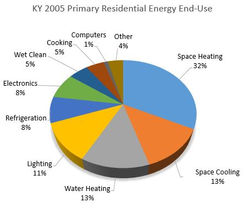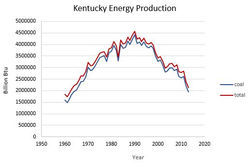Energy Trends
Current Energy Trends
National Trends:
The United States was responsible for 18% of the world's total primary energy consumption in 2012, but holds less than 5% of the global population. The transportation sector uses 45% of all the energy used in the United States. The residential sector uses the second most at 11% of the total consumption.
Each person in the U.S. emitted an average of 18 metric tons of carbon dioxide in 2011. That's equivalent to burning 19,334 pounds of coal, and is the amount of carbon dioxide that is sequestered by 14.8 acres of forest in a year, Use the EPA's carbon footprint calculator to get an estimate of your carbon dioxide emissions.
According to the EPA, carbon dioxide emissions from electricity in homes and business has increased by 28% since the year 1990. This is attributed to the increased use of electricity for heating, cooling, lighting, and appliances. Of all the energy used in homes in 2005, 45% was used for heating and cooling.
The United States released 18 metric tons of carbon dioxide from energy consumption in 2011. Here is how the U.S. compares with some other developed nations. Data Courtesy of the United Stats Energy Administration.
It’s possible to reduce the energy used in U.S. homes up to 33% by just changing behavior regarding electricity usage. The amount of energy used to heat your home can be cut by up to 50% by insulating, caulking gaps in windows and doors, and installing more efficient windows and equipment. Energy used to light your home can be cut by 66% by just using natural light, compact fluorescent lamps, and turning off unused lights.
See even more ways you can reduce your electricity consumption.
Kentucky Trends
Kentucky produced 77.4 million tons of coal in 2014, and was the third highest coal producing state. According to the EIA, coal production in Kentucky has decreased by 56% from the year 1990, and total energy production has decreased by 53%.
The price of residential electricity in Kentucky has increased by 72% since 1992. Clean energy, and more efficient homes are becoming popular because of the increasing costs of electricity, and the environmental impacts of fossil fuel combustion. There are many simple things that can be done to reduce your electricity bill that cost very little to implement. In fact, there are many policies in place that incentivize energy efficiency and can help fund clean energy projects. Our site also outlines recent legislation that has passed regarding clean energy.
Kentucky is the home of the first net zero school in the United States. Net zero mean that the school generates the same amount of electricity that it consumes. Richardsville Elementary School is located in Warren County, and uses solar panels and many other energy efficiency techniques. Projects like this help put Kentucky at the forefront of clean energy development and make the state a much more enjoyable, and healthy place to live.
 |
|---|
 |
 |
 |
 |
